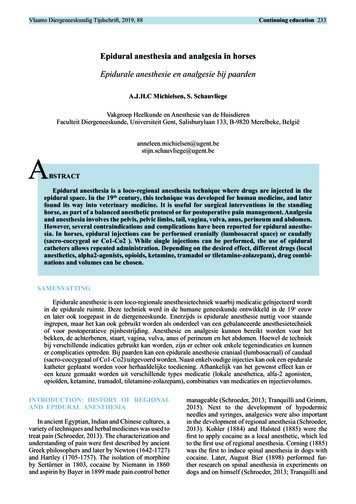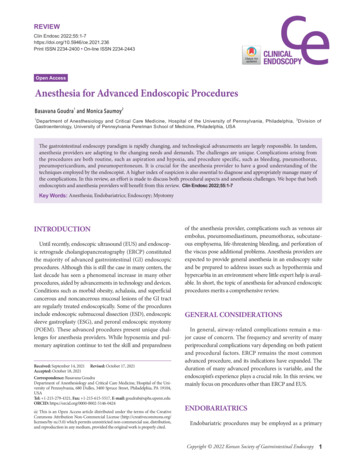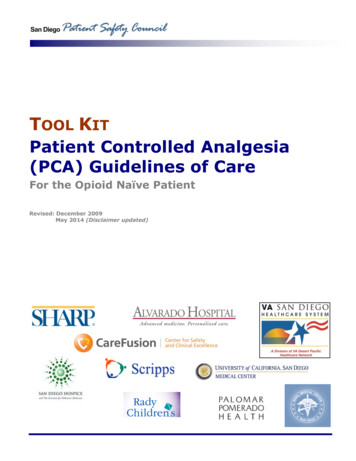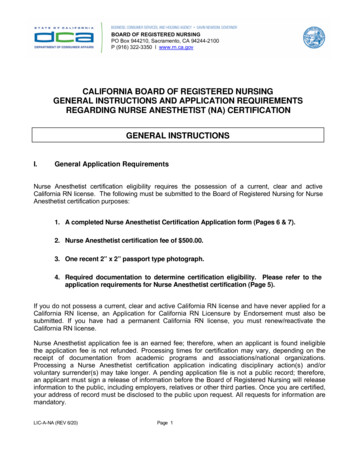
Transcription
Continuing education 233Vlaams Diergeneeskundig Tijdschrift, 2019, 88Epidural anesthesia and analgesia in horsesEpidurale anesthesie en analgesie bij paardenA.J.H.C Michielsen, S. SchauvliegeVakgroep Heelkunde en Anesthesie van de HuisdierenFaculteit Diergeneeskunde, Universiteit Gent, Salisburylaan 133, B-9820 Merelbeke, ege@ugent.beBSTRACTEpidural anesthesia is a loco-regional anesthesia technique where drugs are injected in theepidural space. In the 19th century, this technique was developed for human medicine, and laterfound its way into veterinary medicine. It is useful for surgical interventions in the standinghorse, as part of a balanced anesthetic protocol or for postoperative pain management. Analgesiaand anesthesia involves the pelvis, pelvic limbs, tail, vagina, vulva, anus, perineum and abdomen.However, several contraindications and complications have been reported for epidural anesthesia. In horses, epidural injections can be performed cranially (lumbosacral space) or caudally(sacro-coccygeal or Co1-Co2 ). While single injections can be performed, the use of epiduralcatheters allows repeated administration. Depending on the desired effect, different drugs (localanesthetics, alpha2-agonists, opioids, ketamine, tramadol or tiletamine-zolazepam), drug combinations and volumes can be chosen.SAMENVATTINGEpidurale anesthesie is een loco-regionale anesthesietechniek waarbij medicatie geïnjecteerd wordtin de epidurale ruimte. Deze techniek werd in de humane geneeskunde ontwikkeld in de 19e eeuwen later ook toegepast in de diergeneeskunde. Enerzijds is epidurale anesthesie nuttig voor staandeingrepen, maar het kan ook gebruikt worden als onderdeel van een gebalanceerde anesthesietechniekof voor postoperatieve pijnbestrijding. Anesthesie en analgesie kunnen bereikt worden voor hetbekken, de achterbenen, staart, vagina, vulva, anus of perineum en het abdomen. Hoewel de techniekbij verschillende indicaties gebruikt kan worden, zijn er echter ook enkele tegenindicaties en kunnener complicaties optreden. Bij paarden kan een epidurale anesthesie craniaal (lumbosacraal) of caudaal(sacro-coccygeaal of Co1-Co2) uitgevoerd worden. Naast enkelvoudige injecties kan ook een epiduralekatheter geplaatst worden voor herhaaldelijke toediening. Afhankelijk van het gewenst effect kan ereen keuze gemaakt worden uit verschillende types medicatie (lokale anesthetica, alfa-2 agonisten,opioïden, ketamine, tramadol, tiletamine-zolazepam), combinaties van medicaties en injectievolumes.INTRODUCTION: HISTORY OF REGIONALAND EPIDURAL ANESTHESIAIn ancient Egyptian, Indian and Chinese cultures, avariety of techniques and herbal medicines was used totreat pain (Schroeder, 2013). The characterization andunderstanding of pain were first described by ancientGreek philosophers and later by Newton (1642-1727)and Hartley (1705-1757). The isolation of morphineby Sertürner in 1803, cocaine by Niemann in 1860and aspirin by Bayer in 1899 made pain control bettermanageable (Schroeder, 2013; Tranquilli and Grimm,2015). Next to the development of hypodermicneedles and syringes, analgesics were also importantin the development of regional anesthesia (Schroeder,2013). Kohler (1884) and Halsted (1885) were thefirst to apply cocaine as a local anesthetic, which ledto the first use of regional anesthesia. Corning (1885)was the first to induce spinal anesthesia in dogs withcocaine. Later, August Bier (1898) performed further research on spinal anesthesia in experiments ondogs and on himself (Schroeder, 2013; Tranquilli and
234Figure 1. Schematic overview of the epidural and subarachnoid space.Vlaams Diergeneeskundig Tijdschrift, 2019, 88Grimm, 2015). Because of cocaine’s potentially severe side effects, the search for other local anesthetics began. Molecules, such as procaine and later lidocaine, mepivacaine, etc., were developed (Schroeder,2013). At the beginning of the twentieth century, theuse of local anesthesia techniques had found its wayinto veterinary medicine (Schroeder, 2013). Cuille andSendrail (1901) performed subarachnoid anesthesia inhorses, cattle and dogs. Moreover, Cathelin reportedspinal anesthesia in dogs in 1901, but only from 1920,the technique was performed more frequently in largeanimals (Tranquilli and Grimm, 2015). Nevertheless,it was not until 1950 that epidural anesthesia was being used commonly for surgical procedures in veterinary medicine (Valverde, 2008). With the later development of safer anesthesia techniques and drugs suchas nonsteroidal anti-inflammatory drugs (NSAIDs),regional anesthetic techniques were less often used.(Valverde, 2008; Schroeder, 2013). However, in recent years, epidural anesthesia and analgesia have reemerged as part of balanced anesthetic protocols toprovide good intra- and postoperative analgesia (Valverde, 2008).EPIDURAL ANESTHESIA AND ANALGESIAFigure 2. Epidural catheter for horses.Epidural anesthesia is a form of so-called regionalanesthesia (Muir and Hubbell, 2009). During regionalanesthesia, a specific area of the body, defined by theinnervation pattern of the targeted nerve, is desensitized (Tranquilli and Grimm, 2015). Epidural injections are frequently used in veterinary medicine toprovide analgesia and anesthesia for procedures involving the pelvis, pelvic limbs, tail, perineum andabdomen (Campoy et al., 2015), through injection ofdrugs into the extradural space, i.e. outside the duramater, but underneath the ligamentum flavum (BorerWeir, 2014) (Figure 1). Epidural anesthesia can beprovided by single injection or repeatedly/continuously using an epidural catheter (Figure 2) (Natalini,2010). In human medicine, intrathecal (spinal, subdural or subarachnoid) analgesia is regularly appliedas well. In this case, the drugs are injected into thesubarachnoid space, which contains cerebrospinalfluid (CSF) (Figure 1). The diffusion of the drugs isassisted by the CSF (Borer-Weir, 2014).Anatomy epidural spaceFigure 3. Desensitized subcutaneous area in case of caudal epidural anesthesia depending on volume injectedepidurally. With an increase in volume, more spreading of the epidural injection towards cranial can be observed. Injection of 6, 8 and 10 mL of a local anestheticis depicted in figures A, B and C, respectively (Carpenter and Bryon, 2015).The spinal cord is located within the vertebral canal and courses from the brain until the caudal lumbarregion (Otero and Campoy, 2013). Vertebral archesand bodies, intervertebral discs and intervertebralligaments constitute the outer line of the spinal canal(Borer-Weir, 2014). The spinal canal, the spinal cordand the brain are protected by the meninges and CSF(Otero and Campoy, 2013; Borer-Weir, 2014). Threetissue layers form the meninges around the spinalcord, i.e. the pia mater, arachnoid membrane and dura
Vlaams Diergeneeskundig Tijdschrift, 2019, 88mater (Otero and Campoy, 2013).The pia mater is the inner membrane and is attached to the spinal cord. The arachnoid is the centrallayer and its outer surface is attached to the dura mater, which forms a firm outer surface of the meninges(Otero and Campoy, 2013; Borer-Weir, 2014). Thesubarachnoid space is located between the pia materand the arachnoid membrane and contains CSF (Oteroand Campoy, 2013) (Figure 1). Between the dura mater and the wall of the vertebral canal, a potential spaceis formed, which is called the epidural space (Oteroand Campoy, 2013; Borer-Weir, 2014) (Figure 1). Theepidural space contains blood vessels, nerves, fat andlymphatics. Each nerve root with its associated dorsaland ventral roots is initially covered with an extensionof the dura mater and arachnoid membrane. More distally, the meninges in combination with connectivetissue form the nerve sheets around the peripheralnerves (Otero and Campoy, 2013). The spinal nervesexit from the spinal canal through the intervertebralforamina. After epidural injection, diffusion of drugsinto neural tissue is necessary to achieve a good epidural anesthesia (Borer-Weir, 2014) (Figure 1).IndicationsThe aim of epidural anesthesia is usually to desensitize the caudal and last sacral nerves, providing sen-AB235sory loss of their innervation regions as well as parasympathetic blockage, causing relaxation and dilatation of the anus, bladder and genital organs (Skardaet al., 2009). A caudal epidural injection can provideanesthesia for standing surgery of the rectum, anus,perineum, tail, urethra, bladder, vulva or vagina of sedated horses (Doherty and Valverde, 2006; Skarda etal., 2009; Vigani and Garcia-Pereira, 2014; Carpenterand Bryon, 2015) (Figures 3 and 4). Examples of suchprocedures are correction of a rectum prolapse, rectovaginal fistula or uterine torsion, laparoscopic cryptorchidectomy and fetotomy (Robinson and Natalini,2010). Epidural anesthesia can also be used undergeneral anesthesia for the same anatomical regions(Doherty and Valverde 2006), as part of a multimodalanalgesic plan (Borer-Weir, 2014) or for postoperativeanalgesia, e.g. for painful conditions of the hind legs(Doherty and Valverde, 2006; Carpenter and Bryon,2015) with or without the use of an epidural catheterfor continuous analgesia (Natalani, 2010).ContraindicationsUntreated hypovolemia, septicemia, bacteremia,skin trauma/ infection or neoplasia are absolute contraindications for performing epidural anesthesia(Doherty and Valverde, 2006; Dugdale, 2010a; Love,2012; Campoy et al., 2015, Steagall et al., 2017). Al-CFigure 4. Identification of the caudal epidural injection site between Co1 and Co2. The first coccygeal interspace between Co1 and Co2 can be identified by lowering and raising the tail from its base (A and B) as the first movable joint,since the first coccygeal vertebrae Co1 is usually fused with the sacrum. However, in obese patients, the palpation of theinterspace can be quite challenging. By alternating the angle of the bent of the tail, a depression in the midline caudalto the sacrum can be palpated (C), identifying the first coccygeal interspace. The needle is inserted in this interspacebetween Co1 and Co2 (Skarda et al., 2009).
236Vlaams Diergeneeskundig Tijdschrift, 2019, 88lenging due to a distorted anatomy (Dugdale, 2010;Steagall et al., 2017). In patients with increased intraranial pressure, epidural anesthesia is not advised dueto the possible risk of brain herniation in case of inadvertent intrathecal injection.ComplicationsFigure 5. Examples of different brands of spinal needles.Figure 6. L6: sixth lumbar vertebrae, S1: first sacraldorsal spinous process, Co1 and Co2: first and secondcoccygeal vertebrae. A: cranial epidural anesthesia between L6 and S1: catheter placement for continuouscaudal epidural anesthesia (technically demanding, infrequently performed). B: needle placement for caudalanesthesia perpendicular direction. C: needle introduction under 45 approximately. Once the needle is inserted, the catheter can be introduced over a distanceof 10 to 30 cm into the epidural space. After placementof the catheter, the needle can be removed and the catheter can be secured to the skin. D: needle placement inthe caudal part of the Co1-2 interspace under an angleof approximately 30 for caudal anesthesia (Skarda etal., 2009; Carpenter and Bryon, 2015). Figure adaptedfrom Carpenter and Bryon (2015).ternatives should be considered to provide analgesiain these patients, but also in patients with ataxia orbleeding disorders caused by coagulation disordersor thrombocytopenia to avoid uncontrollable hemorrhage (Dugdale, 2010; Love, 2012; Campoy et al.,2015, Steagall et al., 2017). In obese or trauma patients with pelvic or lumbar spine injury, locatingthe correct anatomical landmarks may be quite chal-Several complications have been reported relatedto epidural injection. Failure to achieve a good anesthesia and analgesia is often related to a poor technique, anatomical anomalies or fibrous scar tissue formation at the site of injection due to previous epiduralinjection (Doherty and Valverde, 2006; Skarda et al.,2009; Carpenter and Bryon, 2015). Severe ataxiaor recumbency may occur in case of an overdose(Doherty and Valverde, 2006; Skarda et al., 2009; Natalini, 2010; Carpenter and Bryon, 2015). Injection ofa large volume or a rapid injection may also causeataxia or general discomfort in the horse. In case ofrecumbency and motor blockage, sedation or light anesthesia of the horse may be necessary until the motorblockage of the hind limbs wears off (Doherty andValverde, 2006; Skarda et al., 2009; Natalini, 2010).The risk of breaking needles is quite low, but can befurther reduced by proper restraint and sedation of thehorse prior to injection. The use of flexible needleswith a stylet can further reduce the risk (Skarda etal., 2009) (Figure 5). Systemic uptake of drugs, especially with the use of an alpha2-agonist, may causesedation and cardiovascular depression (Doherty andValverde, 2006; Skarda et al., 2009). Infection at theinjection site may occur in case of failure of an aseptictechnique (Otero and Campoy, 2013). Systemic uptake or accidental subarachnoid injection of opioidsmay cause central excitation (Natalini, 2010). Inaccurate placement of the epidural catheter or the presenceof congenital membranes or adhesions in the epiduralspace may cause unilateral blockage (Natalini, 2010).Epidural administration of opioids may cause systemic pruritus (Doherty and Valverde, 2006; Carpenterand Bryon, 2015). Other side effects observed afterepidural anesthesia with lidocaine or xylazine are local sweating in the affected regions or perineal edema. Due to a local histamine release, edematous skinwheels can be observed after epidural administrationof morphine (Natalini, 2010). Neurotoxicity remainscontroversial though (Robinson and Natalini, 2010).Drugs without preservatives should be used to avoidany neurotoxicity (Borer-Weir, 2014).EPIDURAL ANESTHESIA AND ANALGESIAIN HORSESEpidural injections can be performed cranially(lumbosacral space) or caudally (sacro-coccygeal orCo1-Co2, ) in horses (Robinson and Natalini, 2010;Natalini, 2010; Love, 2012) (Figure 6).
Vlaams Diergeneeskundig Tijdschrift, 2019, 88LocationCranial epidural injectionCranial epidural injection in horses performed inthe lumbosacral space is less common and is substantially more difficult than caudal epidural injection(Skarda et al., 2009; Love, 2012. In horses, the spinalcord ends at the level of the caudal half of the secondsacral vertebrae (Carpenter and Bryon, 2015). Thismeans that injection at the lumbosacral space carriesa potential risk of puncture of the dura and accidentalinjection into the subarachnoid space, besides an increased risk for motor blockage and ataxia (Dohertyand Valverde, 2006; Carpenter and Bryon, 2015).The lumbosacral intervertebral space is located 1to 2 cm caudal to an imaginary line between the cranial aspects of each tuber coxae and the dorsal midline (Skarda et al., 2009; Carpenter and Bryon, 2015).By applying digital pressure, a depression can be palpated between the dorsal spinous process of L6 andS1 (Skarda et al., 2009). Rectal palpation may also beuseful to locate the L6-S1 intervertebral space (Skarda et al., 2009). Although this technique has its disadvantages, it only requires a small volume, has a rapidonset of anesthesia and there are minimal physiological disturbances (Skarda et al., 2009; Carpenter andBryon, 2015). The desentisized areas are comparablewith those where paravertebral thoracolumbar anesthesia is applied (Figure 7). If an epidural catheter isplaced in caudal direction, caudal epidural anesthesiawill be achieved (Carpenter and Bryon, 2015) (Figure6 (A)).Caudal epidural injectionCaudal epidural injection is performed at the firstcoccygeal interspace (Co1-Co2). This is the preferred, simple, inexpensive and most commonly usedtechnique (Skarda et al., 2009; Carpenter and Bryon,2015). At this level, there is no risk of a spinal injection (Natalini, 2010; Carpenter and Bryon, 2015) andit is less likely to cause a motor blockage to the pelviclimbs (Love, 2012).By raising and lowering the tail, the Co1-Co2interspace can be palpated as the first movable jointcaudal to the sacrum (Figures 4 A and B). A depression in the midline caudal to the sacrum can be palpated (Doherty and Valverde, 2006; Skarda et al., 2009;Carpenter and Bryon, 2015) (Figure 4C).Technique and equipmentA good restraint and preparation of the horse aremandatory when performing epidural anesthesia(Doherty and Valverde, 2006; Skarda et al., 2009;Love, 2012). If possible, the horse should be bearing equal weight on the pelvic limbs (Love, 2012), sooversedation may be avoided (Doherty and Valverde,2006). Regardless of whether a single injection will237be performed or an epidural catheter will be placed,a strictly aseptic technique is necessary (Doherty andValverde, 2006). Hypodermic needles (22, 20 or 18standard wire gauge (SWG)) or spinal needles (depending on the size of the horse) can be used for asingle injection (Figure 5). An injection of local anesthetic around the injection site may be useful to minimize the pain of the procedure (Skarda et al., 2009).After preparation and identification of the correct injection site, the needle can be introduced inthe center of the palpated space, perpendicular to theskin (Figures (6 (A and B)) (Natalini, 2010; Carpenterand Bryon, 2015). A popping sensation may be observed when passing through the ligamentum flavum(Natalini, 2010; Love, 2012; Carpenter and Bryon,2015). To avoid injection in the intervertebral disc,the needle is slightly withdrawn with 5 mm, when theneedle touches the bone (Natalini, 2010; Love, 2012).For cranial and caudal epidural injections, the perpendicular approach can be used (Natalini, 2010; Carpenter and Bryon, 2015). Another technique for caudalepidural anesthesia is the insertion of the needle under an angle of 30 to the horizontal plane (Skarda etal., 2009; Natalini, 2010; Carpenter and Bryon, 2015)(Figure 6 (D)). In adult horses, the needle can be inserted approximately 3.5 to 8 cm to reach the intervertebral space (Carpenter and Bryon, 2015).Correct needle placement can be verified by several methods. Firstly, with the hanging drop technique,a drop of fluid is aspirated from the hub of the needleimmediately after penetration of the ligamentum flavum. This aspiration occurs due to the negative pressure in the epidural space (Doherty and Valverde,2006; Love, 2012; Otero and Campoy, 2013; Carpenter and Bryon, 2015). A second method is the loss ofresistance while injecting air or fluids (Doherty andValverde, 2006; Otero and Campoy, 2013; Carpenterand Bryon, 2015). In small animals, the needle placement can be confirmed by ultrasonography or electrolocation (Otero and Campoy, 2013). Clinical effectssuch as loss of tail or anus tone can be observed afterperforming a successful epidural injection (Dohertyand Valverde, 2006). To ensure there is no intravascular injection, aspiration should be performed prior to aslow injection (Natalini, 2010).Continuous epidural analgesiaIn some cases, repeated epidural drug administration may be necessary to provide prolonged analgesia.Patients with several clinical symptoms such as painful conditions on the hind limbs (fracture, wounds orlacerations) or continuous tenesmus with prolapse ofthe rectum or uterus as a consequence, may benefitfrom epidural analgesia (Carpenter and Bryon, 2015).Epidural catheters can remain in place for periods ofup to twenty days (Martin et al.,2003) (Figures 2 and6 (A and C)). For insertion of a 19 or 20 SWG epiduralcatheter, a 17 or 18 SWG, 17.5 cm Huber point Tuohyneedle (Figures 8 and 9) can be used (Doherty and
238Vlaams Diergeneeskundig Tijdschrift, 2019, 88A bacterial filter can be connected and the site of thecatheter insertion must be covered (Natalini, 2010).With each injection through the epidural catheter,a strictly aseptic technique is required (Doherty andValverde, 2006; Love, 2012). The catheter is preferably flushed with sterile saline after each drug administration (Natalini, 2010).DrugsFigure 7. Desensitized area after cranial epidural injection with segmental blockade.Figure 8. Huber Tuohy needle. This type of needle is especially used while placing an epidural catheter.Figure 9. Tuohy needle tip. The tip of the Tuohy needleis slightly curved and blunt at the end. In this way, ithelps directing the catheter and because of the bluntend, damage to the catheter during placement is prevented (Natalini, 2010).Valverde, 2006; Skarda et al., 2009; Natalini, 2010).An epidural catheter is normally inserted into the epidural space over a distance of 10 to 30 cm beyond thetip of the needle (Natalini, 2010; Carpenter and Bryon, 2015). The catheter mustn’t be introduced furtherthan 30 cm, since kinking of the catheter may occur.The ideal drugs used in the application of epiduralanalgesia should provide analgesia or anesthesia withminimal systemic effects and minimal motor blockade (Valverde, 2008). Drugs or drug combinations arechosen depending on the desired effect and durationof their action. Drugs that can be administered epidurally are alpha2-agonist, local anesthetics, opioids,ketamine, tramadol or tiletamine-zolazepam (Dohertyand Valverde, 2006; Skarda et al., 2009; Carpenterand Bryon, 2015) (Table 1). With higher, epidurallyinjected volumes of (un)diluted drugs or drug combinations, a more rostral spread may occur, resulting ina more cranial epidural block (Doherty and Valverde,2006) (Figure 3). The choice of drugs depends on theindication for which the epidural anesthesia or analgesia is used.Local anesthetics prevent depolarization of thenerves and thus prevent the conduction of any sensory input, including the pain stimulus (Carpenterand Bryon, 2015). However, besides sensory blockage, motor blockage can result from epidural administration of local anesthetics (Robinson and Natalini,2002). Sensory blockage of anus, perineum, rectum,vagina and vulva can be useful in cases of surgery onthe vagina or vulva, for instance the correction of arecto-vaginal fistula (Figure 3). Fetotomy or reducinga prolapse of the rectum, vagina or bladder to avoidcontinued tenesmus are other indications to use local anesthetics in epidural injections (Carpenter andBryon, 2015). The addition of epinephrine to localanesthetic solutions can provide a faster time of onsetand a prolonged effect (Carpenter and Bryon, 2015).Most -if not all- other drugs for epidural use produce analgesia, but no complete anesthesia. This includes alpha-2 agonists, which bind to their receptors in the spinal cord after epidural injection, thusproviding analgesia (Robinson and Natalini, 2002;Carpenter and Bryon, 2015). Motor blockage will notoccur, but ataxia and recumbency are still possible(Robinson and Natalini, 2002). Opioids are potentanalgesics (Robinson and Natalini, 2002). They provide analgesia for longer periods and can be usedalone or in combination with local anesthetics or alpha-2 agonists for acute or chronic pain (Carpenterand Bryon, 2015). Epidural analgesia but no completeanesthesia is achieved by sole administration of anopioid (Doherty and Valverde, 2006). Tramadol, ketamine and tiletamine-zolazepam can also be injectedinto the epidural space, but further studies are needed before their epidural use can be recommended in
Vlaams Diergeneeskundig Tijdschrift, 2019, 88239Table 1. Literature overview of drugs dosages for epidural injection. Drugs that can be administered epidurally arealpha2-agonist, local anesthetics, opioids, ketamine, tramadol and tiletamine-zolazepam.DrugDosage(mg kg-1)Volume mL(500 kg horse)OnsetDuration Remarks(minutes) (minutes)ReferencesLocal anestheticsLidocaine0.2 – 0.255 – 6.55 - 2060- 120 Careful with re-dosing since(20 mg mL-1)overdose can cause ataxia,recumbency and hypotension.Doherty and Valverde, 2006;Dugdale, 2010Love, 2012;Carpenter and Bryon, 2015Ropivacaine0.02 – 0.12 – 1010180(5 mg mL-1)Doherty and Valverde, 2006;Carpenter and Bryon, 2015Minimal ataxia andcardiorespiratory effects.Mepivacaine0.2 – 0.255 – 6.52080(20 mg mL-1)Doherty and Valverde, 2006;Carpenter and Bryon, 2015Bupivacaine(5 mg mL-1)Carpenter and Bryon, 20150.066 6 300Rapid onset and long duration.OpioidsMorphine0.1530 – 180 300Mild systemic effects.(10 mg mL-1)Doherty and Valverde, 2006;Dugdale, 2010; Love, 2012;Carpenter and Bryon, 2015Methadone0.1515300(10 mg mL-1)Rapid onset but intermediatetime of action. Can be dilutedin 10mL 0.9% sterile salinefor a horse of 500 kg.Doherty and Valverde, 2006;Dugdale, 2010; Love, 2012;Carpenter and Bryon, 2015Tramadol110 30240 – 300 Can be diluted in 10 – 20 mL(50 mg mL-1)0.9% sterile saline for a horseof 500 kg.Doherty and Valverde, 2006;Love, 2012; Carpenter andBryon, 2015Alpha-2 agonistXylazine0.17 – 0.22 4.3 – 5.515-30150 - 210(20 mg mL-1)Minimal sedative effects.Can be diluted in 10mL 0.9%sterile saline for a horse of500 kg for perineal analgesic/anesthetic effects or in20 -30 mL for a more rostralspread and analgesic effect.Preferred alpha-2 agonist forepidural use since a more potentantinociceptive effect isobserved with minimal sedativeand cardiovascular side effects.Doherty and Valverde, 2006;Dugdale, 2010; Love, 2012;Detomidine(0.01) –0.5 – 310 – 15120 - 160(10 mg mL-1)0.03 – 0.06Minimal to excessive sedativeDoherty and Valverde, 2006;effects. Can be diluted in maximal Dugdale, 2010; Love, 2012;10mL 0.9% sterile saline for aCarpenter and Bryon, 2015horse of 500 kg to limit rostralspread and its side effects.OtherKetamine0.5 – 22.5 – 105 – 1030 - 80(100 mg mL-1)Systemic effects can occur with Doherty and Valverde, 2006;higher dosages. Dilution ofDugdale, 2010; Love, 2012;ketamine in 10 to 30 mL 0.9%Carpenter and Bryon, 2015sterile saline for a horse of 500 kg.Tiletamine110 30240 - 300zolazepam(Telazol 50 mg and50 mg mL-1)Can be diluted in 10 – 20 mL0.9% sterile saline for a horseof 500 kg. Increase in noxiouspressure stimulus by epiduraladministration but furtherstudies should be conducted.Doherty and Valverde, 2006;Dugdale, 2010;
240horses (Carpenter and Bryon, 2015).Combinations of drugs can increase the durationof analgesia. However, careful dosage is required toavoid adverse effects (Doherty and Valverde, 2006;Carpenter and Bryon, 2015). Opioids combined withalpha-2 agonists can be useful for long term pain management in cases of hind limb pathology with extremelameness. The combination of alpha-2 agonists withlocal anesthetics may give a prolonged effect compared to the local anesthetic alone (Doherty-Valverde,2006).CONCLUSIONEpidural anesthesia and analgesia are effectivetechniques in horses as part of a balanced anesthesiaand for postoperative pain management. Caudal epidural anesthesia is a simple, inexpensive and effective method that can be conducted in equine practicefor different indications. Surgical procedures in theperineal and sacral regions can be performed in combination with sedation to avoid general anesthesia.Different drugs or their combinations may provide adifferent onset and duration of their effect. Providinglonger-term analgesia in pain management is possibledue to the availability of epidural catheters. Complications can occur, but they outweigh the benefits.REFERENCESBorer-Weir K. (2014). Analgesia. In: Clarke K.W., TrimC.M., Hall L.W. (eds.). Veterinary Anesthesia. Eleventhedition, Saunders Elsevier, p 101-133.Campoy L., Read M., Peralta S. (2015). Canine and felinelocal anesthetic and analgesic techniques. In: GrimmK.A., Lamont L.A., Tranquilli W.J., Green S.A., Robertson S.A. (eds.). Veterinary Anesthesia and Analgesia.Fifth edition, Lumb and Jones. Fifth ed, Wiley Blackwell, Iowa, USA, p 827-856.Carpenter R.E., Bryon C.R. (2015). Equine local anestheticsand analgesic techniques, In: Grimm K.A., Lamont L.A.,Tranquilli W.J., Green S.A., Robertson S.A. (eds.). Veterinary Anesthesia and Analgesia. Fifth edition, Lumband Jones, Wiley Blackwell, Iowa, USA, p 886-911.Doherty T., Valverde A. (2006). Epidural analgesia and anesthesia. In: T. Doherty, A. Valverde (eds.). Manuel ofEquine Anesthesia & Analgesia. First edition, BlackwellPublising, Oxford, UK, p 275 -281.Dugdale A. (2010a). Local anaesthetic techniques for thelimbs Small animals, In: Dugdale A. (ed.) VeterinaryAnaesthesia Principles to Practice. Firstedition, WileyBlackwell, Iowa, USA, p 123-131.Dugdale A. (2010b). Local anaesthetic techniques for thelimbs Horses, In: Dugdale A (ed.). Veterinary Anaesthesia Principles to Practice. First edition, Wiley Blackwell,Iowa, USA, p135-140.Love E.J. (2012). Equine pain management. In: Auer J.A.,Stick J.A. (eds.). Equine Surgery. Fourth edition, Saunders Elsevier, p 263-270.Vlaams Diergeneeskundig Tijdschrift, 2019, 88Martin C.A., Kerr C.L., Pearce S.G., Lansdowne J.L.,Bouré L.P. (2003). Outcome of epidural catherization fordelivery of analgesics in horses: 43 cases (1998-2001)Journal of American Veternary Medical Association, 10,1394-1398.Muir W.W., Hubbell J.A.E. (2009). History of equine anesthesia. In: Muir W.W., Hubbell J.A.E. (eds.). EquineAnesthesia: Monitoring and Emergency therapy. Secondedition, Saunders Elsevier, p 1-10.Natalini C.C. (2010). Spinal anesthetics and analgesics inthe horse. Veterinary Clinics of North America: EquinePractice 26, p551-564.Otero P.E., Campoy L. (2013). Epidural and spinal anesthesia, In Campoy L., Read M.R. (eds.). Small Animal Anesthesia and Analgesia. First edition, Blackwell Publising,Oxford, UK, p 227-260.Robinson E.P., Natalini C.C (2002). Epidural anesthesiaand analgesia in horses. The Veterinary Clinics EquinePractice 18, 61-82.Schroeder K. (2013). History of regional anesthesia. In:Campoy L., Read M.R. (eds.). Small Animal Anesthesiaand Analgesia. First edition, Blackwell Publishing, Oxford, UK, p 3-10.Skarda R.T., Muir W.W., Hubbell J.A.E. (2009). Local anesthetic drugs and techniques. In: Muir W.W., HubbellJ.A.E. (eds.). Equine Anesthesia Monitoring and Emergency Therapy. Second e
a large volume or a rapid injection may also cause ataxia or general discomfort in the horse. In case of recumbency and motor blockage, sedation or light an - esthesia of the horse may be necessary until the motor blockage of the hind limbs wears off (Doherty and Valverde, 2006; Skarda et al., 2009; Natalini, 2010).










